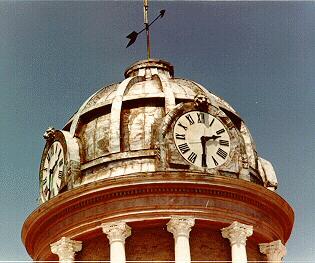Cordell was platted in 1901, by A. J. Johnson and
James C. Harrel. In 1894 Harrell bought out a squatter's rights,
by trading him 3 horses for his claim (southwest quarter of
section 34, township 10, range 17). Improvements at that time
consisted of a dug-out, a well, and eight acres of breaking.
Harrel continued to teach school and improve his farm, until he
succeeded in getting fifty acres broken. He married in 1895 to Miss
Eva Petty, and kept on farming his land.
In 1897 Harrel and Johnson, who owned adjoining quarter sections,
arranged to plat their land into a townsite. The section line became
main street of the new townsite. The beginning of New Cordell.
The Cordell post office had been established October 12, 1892, a
mile and a half to the east before Johnson and Harrel's townsite
plat. When the new townsite was platted the first house was moved
over from Texas, and the postmistress brought the mail over from the
old town in her apron. The postmistress kept a small lodging house.
Cordell was named for Wayne W. Cordell, long time employee of the
Post Office Department.
Each man managed the sale and distribution of his own lots, each
donating land for the courthouse square. The seat of government was
located at Cordell in 1901, by a vote of the people. Mr. Harrel, as
one of the founders of the town of Cordell, refused to sell a lot
for the use of a saloon.
Soon the old town was all moved over, and stores and shops were
soon provided in the new place. During the first years of the town's
history, Mr. Harrel erected a twenty-five hundred dollar school
building, assisted by other citizens. Mr. Harrel continued to dwell
within his humble dug-out all this time, and was the teacher of this
pioneer school.
The town increased to a population of more than twenty-five
hundred and included a graded school and two academies, churches,
shops, banks, etc. all to do with a thriving town.
When the Frisco railroad was heading toward Cordell, donations
and local support was sought by Dr.
J. E. Farber. He was active in securing the line, and with other
local men organized the Cordell Improvement Company, of which he was
made president. They purchased the required land and gave it to the
railroad company, which induced the company to build into the town.
He also assisted in organizing the Otter Creek Irrigation Company,
with a million dollars capital, with a plant near Mountain Park,
Oklahoma, on the Frisco line of railway.
Cordell continues to be a thriving town.
 The
original Tower Clock in the Washita County Courthouse was installed
in 1914. In 1954 the clock works was removed in the tower and an
electric clock was put together, piece by piece. The caretaker for
the clock is retired Washita County Commissioner Alfred H. Miller.
Alfred lives just outside Cordell, Oklahoma.
The
original Tower Clock in the Washita County Courthouse was installed
in 1914. In 1954 the clock works was removed in the tower and an
electric clock was put together, piece by piece. The caretaker for
the clock is retired Washita County Commissioner Alfred H. Miller.
Alfred lives just outside Cordell, Oklahoma.
Alfred said the clock is a monstrosity of a contraption, but
keeps excellent time. There is no stairway leading up into the dome,
so the caretaker must use a lineman's harness and ropes to ascend
into the tower.
 Cemeteries
Cemeteries  Index
Index  Lookups
Lookups  Maps
Maps  Resources
Resources  Search
Search  Towns
Towns Cemeteries
Cemeteries  Index
Index  Lookups
Lookups  Maps
Maps  Resources
Resources  Search
Search  Towns
Towns